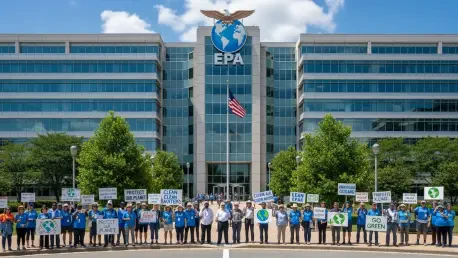Imagine a federal agency tasked with safeguarding the environment, now caught in a storm of internal conflict over free speech and scientific integrity, where over 140 employees of the Environmental Protection Agency (EPA) have been placed on administrative leave. Their suspension follows participation in a bold “Declaration of Dissent,” a document signed by more than 600 staff members criticizing the current administration’s policies. This controversy has ignited a fierce debate about the balance between governmental authority and individual expression. This roundup gathers diverse opinions, insights, and analyses from senators, unions, environmental groups, and legal experts to unpack the implications of this standoff and explore what it means for federal agencies navigating political pressures.
Unpacking the EPA Suspensions: A Clash of Ideals
Background of the Controversy
The suspensions at the EPA stem from a powerful statement of dissent that accuses the administration of undermining the agency’s core mission. The declaration, initially signed by nearly 300 employees and later expanding to over 600, highlights concerns over the neglect of science and environmental justice. Publicly shared with lawmakers, the document has become a flashpoint, with the EPA administration labeling it as an act of sabotage. This situation reveals a profound rift within the agency about the role of critique during politically charged times.
Diverse Stakeholder Reactions
Various stakeholders have weighed in on the suspensions, reflecting a spectrum of views on how dissent should be handled within federal institutions. A coalition of 17 Senate Democrats has taken a firm stand, arguing that the suspensions violate constitutional protections and stifle necessary dialogue. In contrast, EPA officials defend their actions by emphasizing the need for operational unity and alignment with administrative goals. Meanwhile, environmental advocacy groups express alarm over the potential chilling effect on employees who might fear retaliation for speaking out on critical issues.
Broader Implications for Federal Workplaces
Beyond the immediate conflict, opinions differ on what this incident signals for other government bodies. Some policy analysts suggest that the EPA case could set a precedent for how dissent is managed, potentially leading to stricter controls if left unchallenged. Others, including union representatives, believe it may galvanize efforts to protect whistleblowers and ensure that federal employees can voice concerns without risking their livelihoods. This divergence in perspective underscores the complexity of maintaining workplace harmony while fostering open discourse.
Key Opinions on the Core Issues
The Declaration of Dissent: A Stand for Integrity
At the heart of this controversy lies the “Declaration of Dissent,” seen by many as a courageous call to preserve the EPA’s purpose. Supporters, including environmental nonprofits, view the document as a necessary pushback against policies they believe erode public trust and scientific standards. They argue that such collective action is vital for holding leadership accountable, especially in an era of heightened political influence over regulatory bodies.
On the other hand, some administrative insiders caution that public dissent of this scale can disrupt agency functionality. They contend that while individual opinions matter, coordinated efforts like the declaration risk undermining the chain of command essential for effective governance. This tension highlights a fundamental question about whether internal criticism should be aired publicly or confined to private channels.
A third angle comes from academic circles, where scholars of public policy note that dissent often drives innovation in government work. They point to historical examples where employee feedback led to significant reforms, suggesting that the EPA could benefit from embracing rather than punishing such input. This viewpoint adds depth to the ongoing debate over the declaration’s ultimate impact.
Legal Arguments: First Amendment in Focus
Legal perspectives on the suspensions center on the First Amendment rights of public employees. Senate Democrats, leading the charge for reinstatement, reference landmark Supreme Court rulings to assert that staff members speaking on matters of public concern are protected from retaliation. This legal foundation is seen as a cornerstone for ensuring that government workers can contribute to public discourse without fear.
Conversely, some legal analysts aligned with administrative interests argue that there are limits to such protections when speech interferes with an agency’s mission. They emphasize that while personal opinions are safeguarded, actions perceived as collective insubordination may justify disciplinary measures. This interpretation raises questions about where the boundary lies in politically sensitive environments like the EPA.
A balanced take from independent legal observers suggests that the resolution of this case could hinge on how courts define the context of the employees’ actions. If the declaration is deemed a personal expression rather than an act of workplace disruption, reinstatement seems likely. This uncertainty fuels ongoing discussions about the need for clearer federal guidelines on employee speech.
Tensions Between Control and Freedom
The clash between administrative authority and individual expression has elicited varied responses from different sectors. Union leaders argue that the suspensions represent an overreach that could deter employees across federal agencies from raising valid concerns. They stress that a culture of fear ultimately harms public service by silencing critical voices needed for robust policymaking.
From a management perspective, some government consultants maintain that leaders must retain the ability to enforce discipline to prevent chaos. They suggest that while dialogue is important, there must be mechanisms to ensure that dissent does not derail agency objectives. This viewpoint prioritizes stability over unrestricted expression, reflecting a pragmatic approach to governance.
Public opinion, as reflected in regional surveys, adds another layer to the debate. In areas with strong environmental advocacy, there is significant support for the suspended staff, with many citizens viewing their actions as a defense of community health and safety. This geographic variation illustrates how local values can shape perceptions of federal conflicts, influencing broader policy conversations.
Support Network: A United Front for Reinstatement
A wide array of voices has rallied behind the suspended EPA employees, forming a coalition of support. Senate Democrats, alongside unions, have been vocal in framing the suspensions as a violation of constitutional rights, urging immediate reinstatement. Their stance is bolstered by the belief that open debate strengthens rather than weakens public institutions.
Environmental organizations echo this sentiment, emphasizing the broader stakes for environmental protection. They argue that silencing dissent within the EPA could have dire consequences for addressing urgent issues like pollution and climate change. Their advocacy highlights the intersection of employee rights and the agency’s mission to safeguard natural resources.
Some public administration experts offer a forward-looking perspective, suggesting that this controversy could prompt reforms in how federal agencies handle internal criticism. They propose that structured forums for employee feedback might prevent such escalations, fostering a healthier balance between authority and input. This idea points to potential long-term solutions amid the current crisis.
Lessons Gathered from the EPA Conflict
The EPA standoff has surfaced critical insights about the state of dissent in federal workplaces. Many policy watchers agree that the scale of employee pushback—evidenced by over 600 signatories—reflects deep-seated frustration with current leadership approaches. This collective action has brought attention to the need for mechanisms that allow for safe expression without jeopardizing careers.
Another key takeaway, drawn from legal and union analyses, is the importance of protecting constitutional rights within government settings. The consensus among many observers is that the EPA’s response risks setting a dangerous precedent for other agencies, potentially curbing essential dialogue. This concern has fueled calls for updated policies that clarify the scope of permissible speech.
Finally, the diverse reactions from senators, advocacy groups, and the public underscore the complexity of balancing control with freedom. While no single solution has emerged, there is a shared recognition that addressing these tensions requires thoughtful dialogue and possibly legislative action. This roundup reflects the multifaceted nature of the issue, capturing the urgency of finding a sustainable path forward.
Reflecting on the Path Taken
Looking back, the EPA suspensions stirred a significant debate that united various groups in defense of employee rights while exposing deep divisions over administrative authority. The legal arguments, grounded in First Amendment protections, clashed with the agency’s need for cohesion, leaving a lasting impression on how dissent is perceived in federal spaces. The coalition of senators, unions, and nonprofits stood as a testament to the power of collective advocacy in challenging perceived overreaches.
Moving forward, stakeholders can take actionable steps by supporting legislative efforts to define clearer boundaries for employee expression within government roles. Engaging with environmental advocacy groups to monitor similar conflicts offers another avenue for impact. Additionally, staying informed about upcoming policy proposals related to federal worker protections can help shape a future where dissent is viewed as a strength rather than a threat, paving the way for more transparent and resilient institutions.









